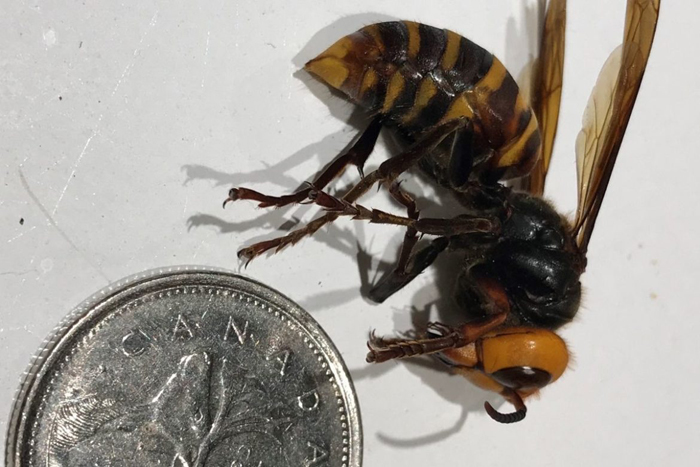B.C. and Washington state governments were boosting the buzz on Asian giant hornets just as spring was on the horizon last week.
Officials from both jurisdictions’ agriculture departments presented a joint news conference on March 17, updating the public on plans for detecting and trapping the invasive species (Vespa mandorinia) and educating them on what to look for.
“Last year half of Washington’s confirmed detections and all of B.C.’s came from alert community members, so the importance of participation from residents can not be overstated,” said Karla Salp, a communications specialist for the Washington State Department of Agriculture.
Thirty-one confirmed Asian giant hornet detections occurred in Washington and six in the Fraser Valley of B.C. in 2020. One of the Washington detections was from a trap that allowed a hornet to be tagged and tracked back to a nest, which was then destroyed. Sven Spichiger of Washington state’s agriculture department said that nest contained 500 specimens and about 200 virgin queens. While the nest was destroyed, it did contain some empty cells, which means queens could have already left and be establishing new nests for this year.
Paul Van Westendorp, the provincial apiculturist for B.C.’s Ministry of Agriculture, Food and Fisheries, said 60 traps were put out by the ministry in 2020, but no hornets were caught in them. More traps will be set this year, he said.
Whatcom County will see some 1,500 traps set: one trap per one kilometre in a grid format, and more if needed, said Spichiger.
Van Westendorp added that no hornets were detected in the Nanaimo area last year after a nest was found and destroyed there in 2019.
Spichiger explained that the hornet queens will emerge from protected cells at this time of year and start to form a nest, eventually rearing a number of workers.
“From about July through September the colony really starts to increase in size,” he said.
Traps are set out from July through November.
Nests are usually found in the ground but the one destroyed in Blaine, Wash. last year was about a foot off the ground in a tree in a family’s yard. The hornets themselves are between 2.7 and five centimetres (one to two inches) in length, with some queens growing even larger.
While the Asian giant hornet does have a powerful sting that can cause death to people who are allergic to them, their nickname “murder hornet” pertains to their voracious appetite for other pollinators such as honeybees and wasps.
Spichiger gave the example of a Washington beekeeper who reported all of the specimens of a very healthy honeybee colony being decapitated by the hornets.
“There are some cascading effects to agriculture that are really quite severe,” he said.
Based on genetic analysis it is believed the Nanaimo introduction originated closer to Japan, as opposed to South Korea like the Washington state specimens. It is speculated that a fertilized queen arrived in Nanaimo in the engine compartment of a new vehicle. Van Westendorp said that suggests the coast will be vulnerable to future introductions via that mode and that vigilance to detect and destroy the hornets will continue to be required.
While Van Westendorp said he is optimistic that the population can be contained in B.C., he feels he has been given adequate resources to tackle the problem this year.
“Here in B.C. we will do whatever it takes to address this issue appropriately.”
British Columbians who think they may have seen an Asian giant hornet or a nest can report their findings to the Invasive Species Council of BC:
• by telephone, toll-free: 1-888-933-3722;
• via the council’s “Report Invasives” mobile phone app, or

